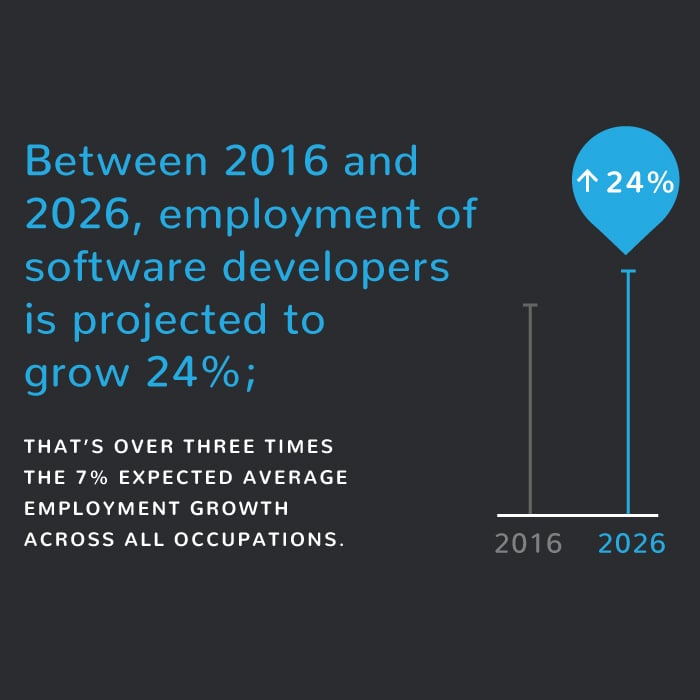The software development industry is currently experiencing a notable technological revolution thanks to the numerous innovations in artificial intelligence and machine learning technologies. Big data’s explosive growth has fueled growth in other industries as more businesses learn to effectively leverage new technology.
In this article, we’ll cover some of the basics of artificial intelligence and machine learning, as well as how these technologies can effectively be implemented in a business setting. We’ll also discuss some of the ethical concerns involved in utilizing advanced technology, and provide information on how you can further your career in data science as well—a career that often begins with learning programming foundations.
The difference between artificial intelligence and machine learning
Both artificial intelligence (AI) and machine learning (ML) technologies have proliferated in the past couple of years, and are steadily revolutionizing the way modern businesses operate, but what’s the difference between the two? The terms AI and ML are two interrelated concepts that are often used interchangeably, although this is not fully accurate.
In general terms, artificial intelligence refers to a machine’s ability to simulate or approximate human intelligence and perform tasks akin to tasks that require human cognition skills—things like decision-making, problem-solving, and interpreting meaning from language.
Machine learning, on the other hand, is a specific technique within the umbrella term of artificial intelligence that involves programming algorithms to make predictions or decisions based on data analysis. In other words, ML could be considered a subset of AI technology that allows machines to “learn” from data and, over time, improve performance.
Another common misconception about machine learning technology is that it’s the same as “deep learning”—which is not true. Deep learning actually refers to a subset of machine learning that relies on neural networks with multiple layers to extract specific features from data sets to achieve higher accuracy ratings in tasks like speech or image recognition. Neural networks consist of networks that are modeled after the human brain. They are composed of interconnected layers of “neurons” that use mathematical algorithms to process data and “learn” from it. This ability to simulate human intelligence makes neural networks a type of artificial intelligence.
Understanding the differences between AI and ML can be vitally important in business settings, especially when making decisions about how to best implement these technologies. For instance, a company may choose to utilize AI to automate routine tasks or to provide more personalized recommendations to customers to improve the customer experience. That same business could also leverage machine learning techniques to analyze large volumes of data and identify patterns or insights that might otherwise be difficult for human data analysts to detect.

How machine learning works
Machine learning can help businesses accomplish more with the same or fewer resources, but how exactly does the process work? Machine learning primarily involves the development of special algorithms and models that enable computers to “learn” from data, identify patterns, and make decisions, or predictions about the future. Oftentimes, the machine learning process looks something like this:
Step 1: Data collection and analysis
In order to learn, ML algorithms need large amounts of data. This data must first be collected, cleaned, and properly formatted to ensure that it is fit for analysis.
Step 2: Model selection, training
Once the data has been aggregated and prepared, a machine learning model is selected based on the ultimate goal of the process. This model is subsequently trained on the data, adjusting parameters to minimize the difference between its predictions and real-world outcomes in the training data.
Step 3: Evaluation
After the model has been selected and trained, it is then evaluated on a separate set of data referred to as the “validation” or “test set” to ensure that the algorithm can generalize to new data and is not overfitting to training data sets.
Step 4: Deployment
When the model has been validated and meets the desired performance requirements, it can be deployed in a business environment where the algorithm can make decisions or predictions based on new input data.
How businesses can utilize machine learning
As one of the most rapidly advancing technological tools in the modern era, machine learning can help businesses improve operations and decision-making processes in a variety of ways. One of the primary examples of where machine learning is used is in software development. By effectively leveraging machine learning algorithms, software developers can optimize workflows by automating repetitive tasks, identifying patterns or anomalies within datasets, and improving general software performance.
Machine learning in software development can be helpful in a variety of scenarios. For example, machine learning can be used to improve the accuracy and efficiency of testing initiatives. Instead of relying on manual or analog tests, machine learning algorithms can automatically generate test cases based on available historical data. They can also help detect bugs and/or errors, and even suggest solutions. This can help businesses by saving valuable time and resources and generally reduces the potential for human error.
Machine learning can also be invaluable for optimizing software performance. By analyzing data from user behavior and system logs, machine learning algorithms can identify certain patterns, trends, and anomalies, and suggest improvements to software architecture that enhance performance. Overall, this can enable businesses to deliver more reliable and efficient software, leading to improved customer satisfaction levels and greater customer retention rates.
Beyond the realm of software development, machine learning has numerous other uses and applications. ML technology can also be used in customer service applications to automatically classify and prioritize incoming requests and even suggest appropriate responses or the best course of action. In the finance sector, machine learning can help with fraud detection efforts, risk analysis, and portfolio optimization in some cases.
But in order for businesses to effectively utilize machine learning technologies, they need access to large amounts of high-quality data. This data needs to be un-siloed, well-organized, and properly labeled, so that machine learning algorithms can engage with the information and extract valuable insights. Additionally, businesses need to have the right tools and the expertise to utilize those tools effectively.

Big data analytics tools
As machine learning technologies have begun to revolutionize the software development industry and others, so too have big data analytics tools begun to change the way companies analyze large amounts of data and extract insights from that data. These tools can empower companies to process and analyze gross volumes of data from numerous sources including social media, transactional data, sensor data, and more, to help identify patterns, trends, and insights that have previously eluded even the most skilled human analysts.
There are a number of big data analytics tools widely available on the market today. These tools can allow companies to ingest, store, and process data, all while utilizing machine learning to extract valuable insights and optimize various aspects of business operations.
But in order to utilize these tools effectively, businesses must have a well-defined and thought-out data strategy that covers everything from data governance to quality control measures and data integration methods. Businesses must also employ a team of data scientists and engineers who design and implement successful machine learning models and algorithms that are well-suited to solve specific problems that the business may be facing.
While there are many ways in which big data analytics tools can support business growth and optimization, there are a number of ethical concerns organizations must also consider when integrating certain technologies into their daily operations.

Ethical issues involved in big data and machine learning
As big data and machine learning capabilities continue to advance at unprecedented rates, businesses must grapple with the ethical issues that can arise from the use of such advanced technologies. One of the most pressing concerns is data privacy. Organizations that are collecting large amounts of data must ensure that the data is handled appropriately and securely in order to protect individuals’ privacy rights. This can include providing transparent explanations of how the data is collected, utilized, and stored.
Another significant ethical issue in regard to machine learning is algorithmic bias. Machine learning algorithms are only as unbiased as the data on which they are trained, which means that if the data used to train algorithms are biased, the resulting algorithms will also be biased and provide biased analyses or predictions. In some cases, this can lead to discrimination against certain groups of people, especially historically marginalized ethnicities and/or genders.
Transparency is another ethical concern within the big data and software development industries. The algorithms used to analyze and make decisions based on data are often highly complex and difficult to understand—even for experts and industry professionals. This can make it difficult for individuals to understand how certain conclusions are reached, which can foster feelings of distrust and skepticism internally and externally as well.
These ethical issues clearly highlight the important role that humans have in managing and analyzing the output coming out of big data and machine learning. Data analysts and scientists may be needed to constantly assess the root data being collected and managed by AI in order to ensure that it is not biased. Furthermore, professionals who understand the space may be best positioned to help build trust between people and machines by breaking down the algorithms in simpler terms.
While big data and software development companies have a great deal of potential to benefit society and business operations immensely, these organizations must seriously consider the ethical ramifications that arise and take steps to ensure that technological advancements are implemented and used in a responsible and ethical manner.
Conclusion
To summarize, there are virtually endless possibilities on the horizon for businesses seeking to improve their operations with AI and ML technologies. And as more organizations come to realize the importance of implementing such technology in the workplace, the need for skilled employees may increase as well.
Devmountain offers several coding bootcamps to help students improve their coding and analytics skills, whether you’re looking for a well-rounded, full-stack Web Development bootcamp education or looking to specialize after your tech-stack foundation on Data Analytics or a data science relevant language like Python. To find out more about how you can advance your career, visit our website today to get started.






